H2 Receptor Antagonist Market Size and Trends
The H2 receptor antagonist Market is estimated to be valued at USD 4.48 Bn in 2025 and is expected to reach USD 6.87 Bn by 2032, growing at a compound annual growth rate (CAGR) of 6.3% from 2025 to 2032.
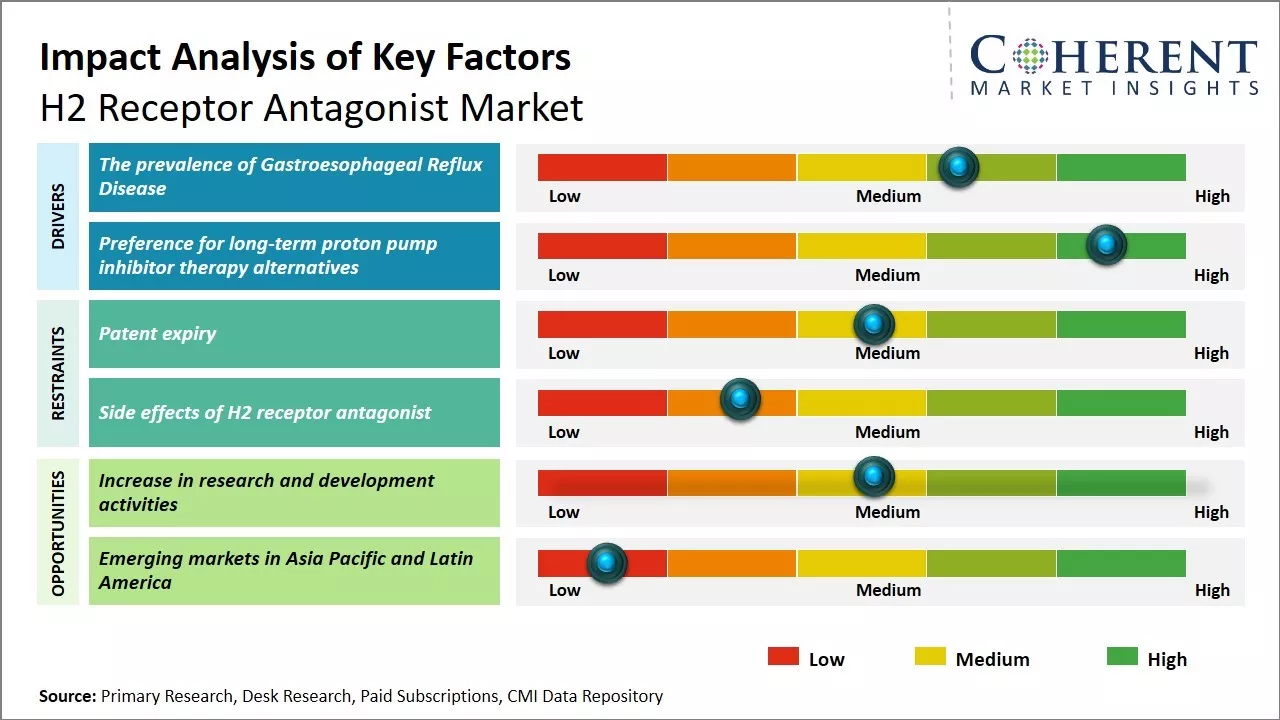
Discover market dynamics shaping the industry: Download Free Sample
The market is primarily driven by the increasing prevalence of acid reflux diseases and peptic ulcers. H2 receptor antagonists are commonly used for short-term treatment of these conditions and see significant demand. The H2 receptor antagonist market is expected to witness steady growth over the forecast period. While several drugs in this category have lost patent exclusivity, resulting in generic competition, there remains a large patient pool being treated for acid reflux diseases. Additionally, the market is anticipated to benefit from the approvals and launches of novel drug delivery formulations such as orally disintegrating tablets. However, the market growth could be hindered by the loss of patients shifting to cheaper generic drugs as well as increasing adoption of proton pump inhibitors, which are often preferred by physicians and patients for long-term acid reflux management.
The Prevalence of Gastroesophageal Reflux Disease
Gastroesophageal reflux disease (GERD) has been on the rise over the past few decades across many countries. It is commonly known as acid reflux or heartburn. GERD occurs when stomach acid flows back up into the esophagus. This backwash (reflux) causes irritation in the esophagus, resulting in symptoms like a burning sensation in the chest and throat, regurgitation of food and sour liquid, difficulty swallowing, coughing, and wheezing. GERD can negatively impact quality of life and lead to complications if left untreated for a long period of time. The exact causes of GERD are not fully known, but there are several contributing factors. Increasing rates of obesity have likely played a major role. Excess abdominal fat is known to increase pressure on the stomach, hindering its ability to keep acid contained. Rising levels of stress, poor eating habits like overeating, eating late at night, and consumption of acidic, spicy or fatty foods can also trigger acid reflux symptoms. With today's busy lifestyles, people also tend to skip meals more often or grab fast food on the go. Advancement in medical diagnostics has enabled doctors to identify GERD more accurately as well.
Market Concentration and Competitive Landscape
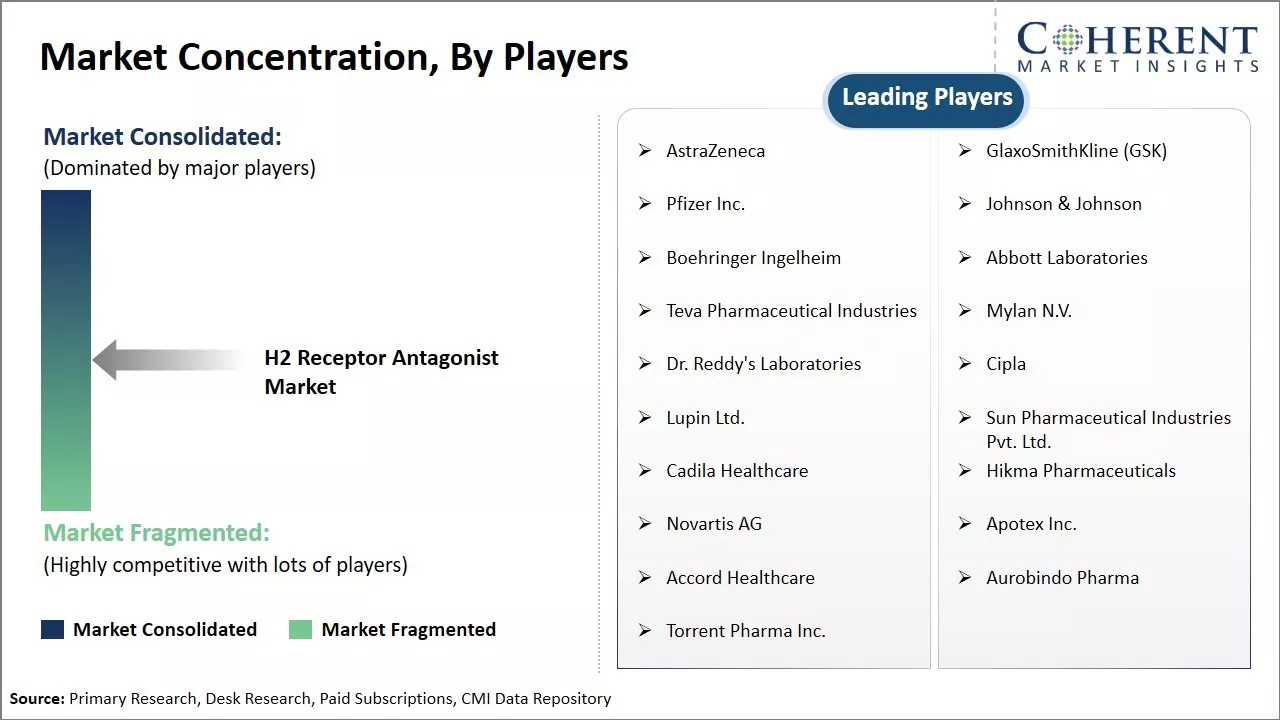
Get actionable strategies to beat competition: Download Free Sample
Preference for Long-Term Proton Pump Inhibitor Therapy Alternatives
Proton pump inhibitors (PPIs) have been the standard initial treatment for GERD and acid reflux disease management. However, frequent and long-term PPI usage can have certain side effects and risks that patients want to avoid if possible. PPIs work by reducing acid production over a longer duration compared to H2 receptor antagonists. While PPIs provide strong acid suppression and are effective against chronic and more severe GERD cases, extended usage.
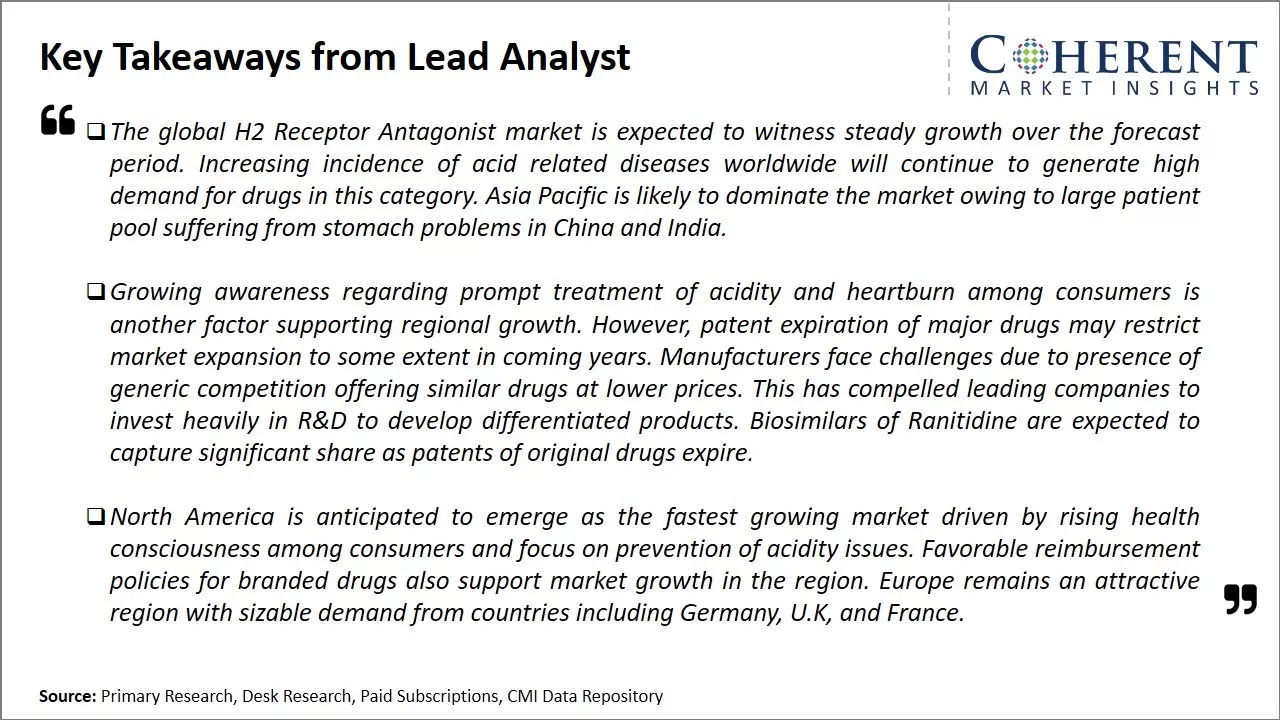
To learn more about this report, Download Free Sample
Market Challenges – Patent Expiry:
The H2 receptor antagonist market faces several challenges. As generic versions of popular drugs go off patent, brand name drugs are experiencing declining sales and profits. Additionally, the development of newer drugs to treat acid-related disorders like proton pump inhibitors (PPIs) has captured significant market share from H2 receptor antagonists. Strict regulatory processes have also increased the costs and time involved in drug development and approval. Finding new therapeutic areas and undergoing additional clinical trials has become important for growth in this maturing market.
Market Opportunities - Increase in research and development activities:
Increased research and development activities can provide significant opportunities for growth in the H2 receptor antagonist market. As new scientific discoveries are made regarding acid reflux disease and gastrointestinal disorders, more effective and targeted treatments may be developed. This research could focus on creating drugs that more selectively block the H2 receptors in the gastric parietal cells without impacting other tissues in the body. More selective receptor antagonism may help reduce side effects that patients sometimes experience from current medications.
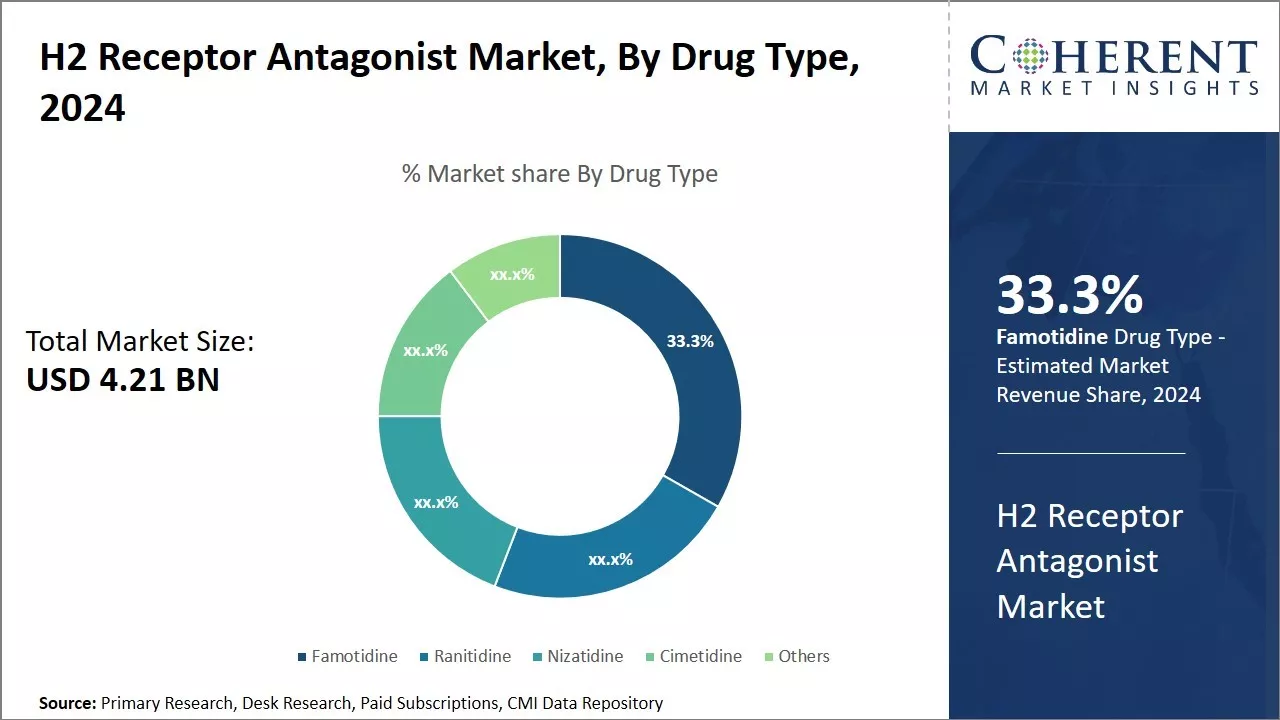
Discover high revenue pocket segments and roadmap to it: Download Free Sample
Insights, By Drug Type: High Prescriptions drives Famotidine’s market dominance
The drug type segment includes famotidine, ranitidine, nizatidine, cimetidine, and others. Famotidine is anticipated to have 33.8% of the H2 receptor antagonist market share in 2024, due to its widespread prescription by physicians for treatment of acid reflux and heartburn.
As per recent prescription trend data by the World Health Organization, nearly 50% of prescriptions for H2 receptor blockers are for famotidine owing to its effectiveness and relatively mild side effects compared to other drugs in this category. Famotidine works by blocking histamine receptors in the stomach lining which reduces the amount of acid produced. Its balanced safety profile makes it a preferred first-line treatment option for acid reflux diseases.
Insights, By Dosage Form: Convenience drives tablets development
The dosage form segment includes tablets, capsules, liquids, powders, and others. Tablets segment is anticipated to register the highest share of 29.7% in 2025. Being easy and hassle-free to consume, tablets are vastly preferred by patients to alternative dosage styles like capsules or liquids. They eliminate preparation steps before use, providing simple "pop and go" usage compatibility with busy modern lifestyles. The convenience appeal of tablets improves medication adherence rates compared to other formats.
Additionally, tablets are extremely portable and stable formulations. They can be comfortably carried anywhere for effortless dosing whenever symptoms arise. No special storage conditions are needed, as may be required for liquid formulations prone to contamination or expiry. Tablets are also discrete and non-messy, helping patients discreetly take medication without drawing attention. This favors tablet usage for sensitive GI issues.
Insights, By Indication: Growing prevalence of GERD
The indication segment includes Gastroesophageal Reflux Disease (GERD), peptic ulcers, zollinger-ellison syndrome, and others. Gastroesophageal reflux disease (GERD) is anticipated to have the highest share i.e. 34.3% in 2025. This is because GERD is effectively treated and provides relief from uncomfortable upper GI symptoms through H2 blockade. GERD patients experience problems like heartburn, acid regurgitation, and chest pain due to stomach acid moving up into the esophagus. H2 antagonists work by reducing stomach acid production, a key driver of GERD symptoms.
Their effectiveness makes H2 antagonists convenient first-line therapy for mild-moderate, on-demand GERD treatment. Patients readily adopt them to relieve bothersome acid reflux symptoms and improve quality of life. Additionally, prescription of H2 blockers as an inexpensive initial treatment option align well with symptom-based GERD management guidelines. This drives significant volumes in this therapeutic area.
Regional Insights
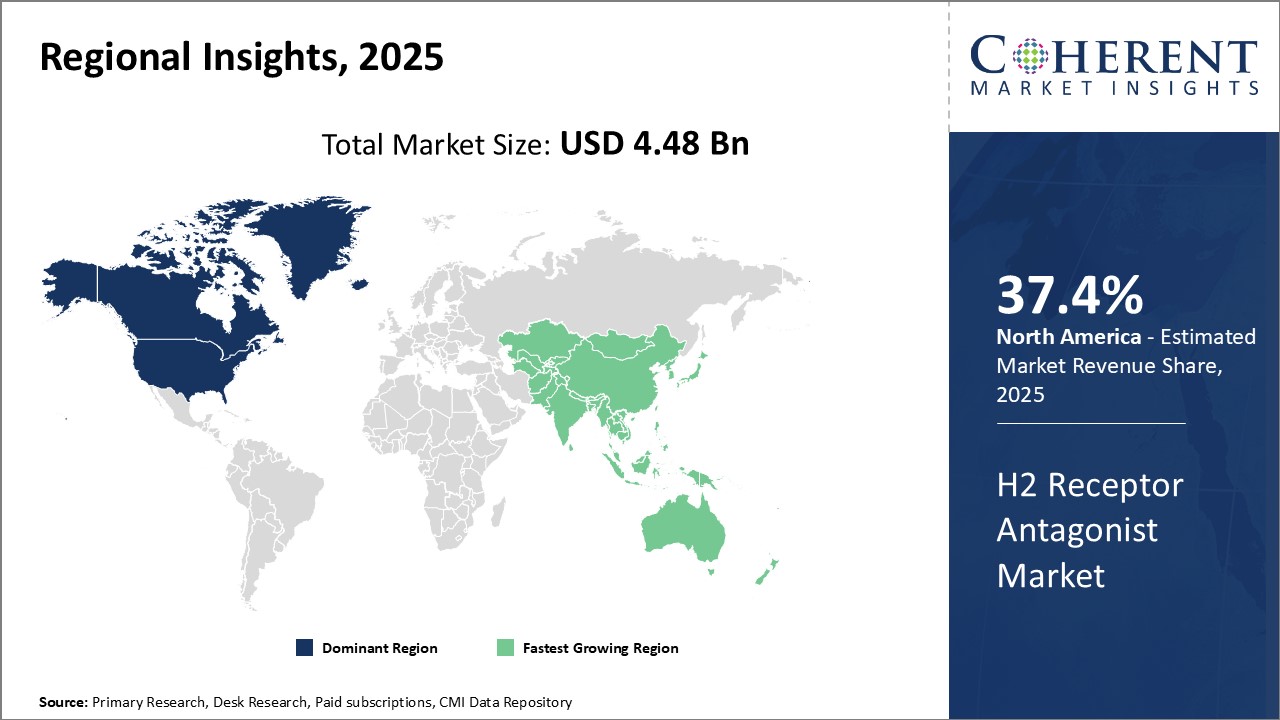
Need a Different Region or Segment? Download Free Sample
North America has established itself as the dominant region, with a market share of 37.4% in the global H2 receptor antagonist market. The key factor contributing to North America's leadership position is the strong presence of leading pharmaceutical companies in the region. Most of the top 10 companies offering H2 receptor antagonists have their headquarters located in the U.S. or Canada. This enables these companies to leverage their R&D and manufacturing infrastructure for continuous new product developments and supply chain optimization. Additionally, North America has a highly developed healthcare infrastructure and high healthcare expenditure per capita which ensures greater affordability and accessibility of H2 receptor antagonist drugs in the region.
The Asia Pacific region has emerged as the fastest growing regional market for H2 receptor antagonists. Several factors are driving the growth of the APAC market. There is a growing focus on modernizing the healthcare systems across APAC countries such as China, India, and Southeast Asian nations. This has increased healthcare spending and prioritization of gastrointestinal disorders by both public and private healthcare players. At the same time, rising living standards are enabling greater affordability and adoption of effective drugs for gastrointestinal issues. The presence of prominent generic drug manufacturers in India and China is also expanding the product portfolio at competitive prices to meet the demand from price-sensitive regions within APAC and other emerging markets. The APAC H2 receptor antagonist market is expected to witness continued growth momentum due to its mssive patient population and fast-paced economic and healthcare infrastructure development.
Market Report Scope
H2 Receptor Antagonist Market Report Coverage
| Report Coverage | Details | ||
|---|---|---|---|
| Base Year: | 2024 | Market Size in 2025: | USD 4.48 Bn |
| Historical Data for: | 2020 To 2024 | Forecast Period: | 2025 To 2032 |
| Forecast Period 2025 to 2032 CAGR: | 6.3% | 2032 Value Projection: | USD 6.87 Bn |
| Geographies covered: |
|
||
| Segments covered: |
|
||
| Companies covered: |
AstraZeneca, GlaxoSmithKline (GSK), Pfizer Inc., Johnson & Johnson, Boehringer Ingelheim, Abbott Laboratories, Teva Pharmaceutical Industries, Mylan N.V., Dr. Reddy's Laboratories, Cipla, Lupin Ltd., Sun Pharmaceutical Industries Pvt. Ltd., Cadila Healthcare, Hikma Pharmaceuticals, Novartis AG, Apotex Inc., Accord Healthcare, Aurobindo Pharma, Torrent Pharma Inc. |
||
| Growth Drivers: |
|
||
| Restraints & Challenges: |
|
||
Uncover macros and micros vetted on 75+ parameters: Get instant access to report
H2 Receptor Antagonist Industry News
- In August 2023, Upsher-Smith Laboratories, LLC, a pharmaceutical company in the U.S., announced the launch of Famotidine for Oral Suspension, USP. The Therapeutic Equivalence (TE) code for Upsher-Smith's product is AB, and the original Reference Listed Drug (RLD) was Pepcid (famotidine) oral suspension.
- In June 2022, Zydus Lifesciences, an India pharmaceutical company, announced that it had received final approval from the US Food and Drug Administration to offer famotidine tablets, an antacid, in the U.S. market
- In September 2020, Amneal Pharmaceuticals, Inc., a publicly traded generic and specialty pharmaceutical company, announced that their nizatidine oral solution 15 mg/mL (75 mg/5 mL) is now available for reordering. The medicine, a generic version of Axid, is the only oral liquid form of nizatidine available in the U.S. The Amneal product satisfies all FDA criteria and National Disaster Management Authority (NDMA) specifications.
- In October 2020, Reddy's Laboratories Ltd., a multinational pharmaceutical company, announced the relaunch of over-the-counter (OTC) Famotidine Tablets USP, 10 mg and 20 mg, the store-brand equivalents of Original Strength and Maximum Strength Pepcid AC, in the U.S., following U.S. Food and Drug Administration (FDA) approval.
*Definition: The H2 receptor antagonist market involves pharmaceutical products that work by blocking histamine H2 receptors in the stomach. This helps to reduce the amount of acid produced by cells in the lining of the stomach. H2 receptor antagonists, also known as H2 blockers, are used to treat conditions where there is excess stomach acid such as ulcers, gastroesophageal reflux diseas,e and Zollinger-Ellison syndrome. Some popular H2 blockers include cimetidine, famotidine, ranitidine, nizatidine and others.
Market Segmentation
- Drug Type Insights (Revenue, USD BN, 2020 - 2032)
- Famotidine
- Ranitidine
- Nizatidine
- Cimetidine
- Others
- Dosage Form Insights (Revenue, USD BN, 2020 - 2032)
- Tablets
- Capsules
- Liquids
- Powders
- Others
- Indication Insights (Revenue, USD BN, 2020 - 2032)
- Gastroesophageal Reflux Disease (GERD)
- Peptic Ulcers
- Zollinger-Ellison Syndrome
- Others
- Distribution Channel Insights (Revenue, USD BN, 2020 - 2032)
- Online Pharmacies
- Retail Pharmacies
- Hospital Pharmacies
- Regional Insights (Revenue, USD BN, 2020 - 2032)
- North America
- U.S.
- Canada
- Latin America
- Brazil
- Argentina
- Mexico
- Rest of Latin America
- Europe
- Germany
- U.K.
- Spain
- France
- Italy
- Russia
- Rest of Europe
- Asia Pacific
- China
- India
- Japan
- Australia
- South Korea
- ASEAN
- Rest of Asia Pacific
- Middle East
- GCC Countries
- Israel
- Rest of Middle East
- Africa
- South Africa
- North Africa
- Central Africa
- North America
- Key Players Insights
- AstraZeneca
- GlaxoSmithKline (GSK)
- Pfizer Inc.
- Johnson & Johnson
- Boehringer Ingelheim
- Abbott Laboratories
- Teva Pharmaceutical Industries
- Mylan N.V.
- Dr. Reddy's Laboratories
- Cipla
- Lupin Ltd.
- Sun Pharmaceutical Industries Pvt. Ltd.
- Cadila Healthcare
- Hikma Pharmaceuticals
- Novartis AG
- Apotex Inc.
- Accord Healthcare
- Aurobindo Pharma
- Torrent Pharma Inc.
Share
Share
About Author
Ghanshyam Shrivastava - With over 20 years of experience in the management consulting and research, Ghanshyam Shrivastava serves as a Principal Consultant, bringing extensive expertise in biologics and biosimilars. His primary expertise lies in areas such as market entry and expansion strategy, competitive intelligence, and strategic transformation across diversified portfolio of various drugs used for different therapeutic category and APIs. He excels at identifying key challenges faced by clients and providing robust solutions to enhance their strategic decision-making capabilities. His comprehensive understanding of the market ensures valuable contributions to research reports and business decisions.
Ghanshyam is a sought-after speaker at industry conferences and contributes to various publications on pharma industry.
Missing comfort of reading report in your local language? Find your preferred language :
Transform your Strategy with Exclusive Trending Reports :
Frequently Asked Questions
EXISTING CLIENTELE
Joining thousands of companies around the world committed to making the Excellent Business Solutions.
View All Our Clients
